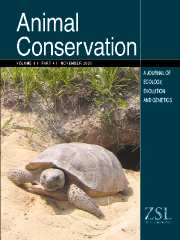Crossref Citations
This article has been cited by the following publications. This list is generated based on data provided by
Crossref.
Jennelle, Christopher S.
Runge, Michael C.
and
MacKenzie, Darryl I.
2002.
The use of photographic rates to estimate densities of tigers and other cryptic mammals: a comment on misleading conclusions.
Animal Conservation,
Vol. 5,
Issue. 2,
p.
119.
Carbone, C.
Christie, S.
Conforti, K.
Coulson, T.
Franklin, N.
Ginsberg, J. R.
Griffiths, M.
Holden, J.
Kinnaird, M.
Laidlaw, R.
Lynam, A.
MacDonald, D. W.
Martyr, D.
McDougal, C.
Nath, L.
O'Brien, T.
Seidensticker, J.
Smith, J. L. D.
Tilson, R.
and
Wan Shahruddin, W.N.
2002.
The use of photographic rates to estimate densities of cryptic mammals: response to Jennelle et al..
Animal Conservation,
Vol. 5,
Issue. 2,
p.
121.
Silveira, Leandro
Jácomo, Anah T.A.
and
Diniz-Filho, José Alexandre F.
2003.
Camera trap, line transect census and track surveys: a comparative evaluation.
Biological Conservation,
Vol. 114,
Issue. 3,
p.
351.
O'Brien, Timothy G.
Kinnaird, Margaret F.
and
Wibisono, Hariyo T.
2003.
Crouching tigers, hidden prey: Sumatran tiger and prey populations in a tropical forest landscape.
Animal Conservation,
Vol. 6,
Issue. 2,
p.
131.
Karanth, K. Ullas
Chundawat, Raghunandan S.
Nichols, James D.
and
Kumar, N. Samba
2004.
Estimation of tiger densities in the tropical dry forests of Panna, Central India, using photographic capture–recapture sampling.
Animal Conservation,
Vol. 7,
Issue. 3,
p.
285.
de Almeida Jácomo, Anah Tereza
Silveira, Leandro
and
Diniz‐Filho, José Alexandre Felizola
2004.
Niche separation between the maned wolf (Chrysocyon brachyurus), the crab‐eating fox (Dusicyon thous) and the hoary fox (Dusicyon vetulus) in central Brazil.
Journal of Zoology,
Vol. 262,
Issue. 1,
p.
99.
Wegge, Per
Pokheral, Chiranjibi Pd.
and
Jnawali, Shant Raj
2004.
Effects of trapping effort and trap shyness on estimates of tiger abundance from camera trap studies.
Animal Conservation,
Vol. 7,
Issue. 3,
p.
251.
Maffei, Leonardo
Cuéllar, Erika
and
Noss, Andrew
2004.
One thousand jaguars (Panthera onca) in Bolivia's Chaco? Camera trapping in the Kaa‐Iya National Park.
Journal of Zoology,
Vol. 262,
Issue. 3,
p.
295.
Scott, D.M.
Waite, S.
Maddox, T.M.
Freer, R.A.
and
Dunstone, N.
2005.
The validity and precision of spotlighting for surveying desert mammal communities.
Journal of Arid Environments,
Vol. 61,
Issue. 4,
p.
589.
Trolle, Mogens
and
Kéry, Marc
2005.
Camera-trap study of ocelot and other secretive mammals in the northern Pantanal.
mamm,
Vol. 69,
Issue. 3-4,
p.
409.
Sharma, Sandeep
Jhala, Yadvendradev
and
Sawarkar, Vishwas B.
2005.
Identification of individual tigers (Panthera tigris) from their pugmarks.
Journal of Zoology,
Vol. 267,
Issue. 1,
p.
9.
Gómez, Humberto
Wallace, Robert B.
Ayala, Guido
and
Tejada, Renata
2005.
Dry season activity periods of some Amazonian mammals.
Studies on Neotropical Fauna and Environment,
Vol. 40,
Issue. 2,
p.
91.
Rovero, F.
Jones, T.
and
Sanderson, J.
2005.
Notes on Abbott's duiker (Cephalophus spadixTrue 1890) and other forest antelopes of Mwanihana Forest, Udzungwa Mountains, Tanzania, as revealed by camera-trapping and direct observations.
Tropical Zoology,
Vol. 18,
Issue. 1,
p.
13.
LINKIE, MATTHEW
CHAPRON, GUILLAUME
MARTYR, DEBORAH J.
HOLDEN, JEREMY
and
LEADER‐WILLIAMS, NIGEL
2006.
Assessing the viability of tiger subpopulations in a fragmented landscape.
Journal of Applied Ecology,
Vol. 43,
Issue. 3,
p.
576.
Di Bitetti, M. S.
Paviolo, A.
and
De Angelo, C.
2006.
Density, habitat use and activity patterns of ocelots (Leopardus pardalis) in the Atlantic Forest of Misiones, Argentina.
Journal of Zoology,
Vol. 270,
Issue. 1,
p.
153.
Johnson, A.
Vongkhamheng, C.
Hedemark, M.
and
Saithongdam, T.
2006.
Effects of human–carnivore conflict on tiger (Panthera tigris) and prey populations in Lao PDR.
Animal Conservation,
Vol. 9,
Issue. 4,
p.
421.
JACKSON, RODNEY M.
ROE, JERRY D.
WANGCHUK, RINCHEN
and
HUNTER, DON O.
2006.
Estimating Snow Leopard Population Abundance Using Photography and Capture–Recapture Techniques.
Wildlife Society Bulletin,
Vol. 34,
Issue. 3,
p.
772.
Soisalo, Marianne K.
and
Cavalcanti, Sandra M.C.
2006.
Estimating the density of a jaguar population in the Brazilian Pantanal using camera-traps and capture–recapture sampling in combination with GPS radio-telemetry.
Biological Conservation,
Vol. 129,
Issue. 4,
p.
487.
GOMPPER, MATTHEW E.
KAYS, ROLAND W.
RAY, JUSTINA C.
LAPOINT, SCOTT D.
BOGAN, DANIEL A.
and
CRYAN, JASON R.
2006.
A Comparison of Noninvasive Techniques to Survey Carnivore Communities in Northeastern North America.
Wildlife Society Bulletin,
Vol. 34,
Issue. 4,
p.
1142.
Dajun, Wang
Sheng, Li
McShea, William J.
and
Fu, Li Ming
2006.
Use of Remote-Trip Cameras for Wildlife Surveys and Evaluating the Effectiveness of Conservation Activities at a Nature Reserve in Sichuan Province, China.
Environmental Management,
Vol. 38,
Issue. 6,
p.
942.


